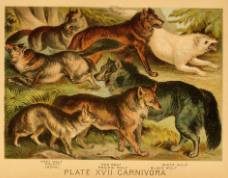Past Fashion Trends Shown In Art
March 14, 2022
We admire paintings with unique features, big or small. We get lost in unique beauty. After all, art is supposed to be admired. Unfortunately, with current trends of beauty standards pushed onto women, we are left discouraged. We often forget that we as humans are art and deserve to be admired by ourselves.
Society has always had a preferred look on women and men, but now it seems beauty is only accompanied by women. If we take a glance at our past, it would be clear when gender roles became a factor of beauty. Most things created “for” women were made for men first, such as the iconic color pink shown in one of John Vanderbank’s paintings depicting a boy in a pink suit. John was a famous painter back in the 1700s. Another example of men wearing pink back when gender roles weren’t what they presently are, is a portrait of Gian Girolamo Grumelli, “le Chevalier en rose,” done in 1561 by Giovan Battista Moroni. These two paintings show us that pink stood for a more masculine look back then even though it was socially acceptable for both genders to wear it. Pink was advertised to be a more “washed” down version of the color of red, it was often used among male children. However, “le Chevalier en rose” once again presents us that it was also acceptable for grown men to wear the color pink. The common idea of what our society has of the color pink didn’t play a role until the 1940s.
The color pink wasn’t the only trend that men created for themselves, but also high heels. Men wore high heels back in the 10th century and are shown in the “Portrait of Louis XIV,” who was the king of France, and in “James Maitland, 7th Earl of Lauderdale” by Sir Joshua Reynolds. Both of these paintings illustrate two powerful men wearing high heels. Of course, there were reasons behind such clothing. High heels helped men who participated in the Persian cavalry, an army, to keep their feet in stirrups. Although high heels themselves went through several cultural meanings, high heels soon became a symbol of high social stature and were even viewed as cool. High heels then took a 180-degree turn in the mid-1500s and began to be viewed as feminine.
Of course, clothing wasn’t the only thing changing, but also our features. In 2022, the standard beautiful noses are small and narrow, often called “button noses.” However, paintings depict women with long bumpy bridges and were viewed as beautiful. Often called the Aquiline nose, these noses were depicted in several paintings, such as the popular “Portrait of a woman in side profile” by Paolo Uccello. These noses are often seen as a “Roman nose,” as in Roman days men also craved this characteristic in women. The nose would serve as a mark for beauty and nobility.
Eyebrows were also a recurring trend, back in the 20th century. Having a unibrow signified intelligence and great beauty in women. However, during the middle ages of the Renaissance, people were captivated by having big foreheads. The meaning is unknown, but women started plucking their eyebrows to appear to have an oval face structure, which soon gradually turned into the fascination of having big foreheads.
However, as trends come and go, you as an individual captivate your own unique beauty. With this time of age, it’s difficult to maintain standing when you begin doubting yourself and what you hold dear. You may not be a painting, but you are art.










































































































































